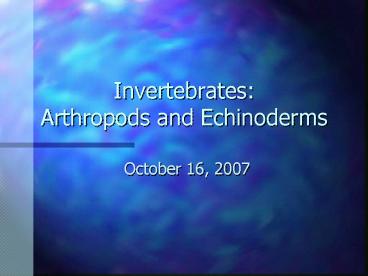Invertebrates: Arthropods and Echinoderms - PowerPoint PPT Presentation
1 / 26
Title:
Invertebrates: Arthropods and Echinoderms
Description:
A network of canals, valves, and suckers ... Aristotle's lantern - jawlike structure. Made of specialized ossicles, and moved by muscles ... – PowerPoint PPT presentation
Number of Views:174
Avg rating:3.0/5.0
Title: Invertebrates: Arthropods and Echinoderms
1
InvertebratesArthropods and Echinoderms
- October 16, 2007
2
Phylum Arthropoda
- Most species of any phylum (1 million)
- Segmented, bilaterally symmetrical body
- Jointed appendages
- Exoskeleton made of chitin
- Growth requires molting
3
http//www.biologycorner.com/resources/arthropod_c
hart.gif
4
Phylum Arthropoda - Subphylum Crustacea
- Most species marine
- Gills
- 2 pairs of antennae
- Zooplankton Crustaceans
- Copepods
- Krill
- Amphipods
5
Phylum Arthropoda - Subphylum Crustacea
- Barnacles
6
Phylum Arthropoda - Subphylum Crustacea
- Isopods
http//www.mbari.org/news/news_releases/2006/snail
size-images/giant_isopod_450.jpg
7
Phylum Arthropoda - Subphylum Crustacea
- Decapoda
- Shrimp
- Crabs
- Lobsters
8
Phylum Arthropoda - Subphylum Crustacea
9
Phylum Arthropoda - Subphylum Crustacea
10
Phylum Arthropoda - Subphylum Chelicerata
- Horseshoe Crabs
11
Phylum Arthropoda - Subphylum Chelicerata
- Sea Spiders
12
Phylum Echinodermata
- Entirely marine
- About 6000 species
- Pentaradial symmetry
- Spiny skin
- Complete digestive tract
- Endoskeleton
- Water vascular system
13
Phylum Echinodermata
- Water Vascular System
- A network of canals, valves, and suckers
- Water is exchanged across a sieve plate, known as
a madreporite - Uses water pressure to operate many tube feet
- Tube feet can apply suction and also secrete
mucus
http//animaldiversity.ummz.umich.edu/site/account
s/information/Echinodermata.html
14
Phylum Echinodermata
- Class Asteroidea - Sea Stars
15
Phylum Echinodermata
- Class Asteroidea
- Usually carnivorous
- Use tube feet to attach to their prey, and then
feed by extruding their stomach, and digesting
prey mostly outside their body
16
Phylum Echinodermata
- Class Asteroidea
- Keystone Species
17
Phylum Echinodermata
- Class Asteroidea
Crown of Thorns - Acanthaster planci
18
Phylum Echinodermata
- Class Ophiuroidea
http//www.stanford.edu/bhackett/nautilus-2005-08
/pages/basket-star-(b).html
19
Phylum Echinodermata
- Class Echinoidea
- Endoskeleton fused into a round, rigid test
- Movable spines and pedicellarie
- 5 rows of ambulacral grooves
- Herbivores
20
Phylum Echinodermata
- Class Echinoidea
- Aristotles lantern - jawlike structure
- Made of specialized ossicles, and moved by
muscles - Has 5 teeth that come together in a point, and
allow the animal to tear apart seaweeds or scrape
algae off surfaces
21
Phylum Echinodermata
- Class Echinoidea
22
Phylum Echinodermata
- Class Holothuroidea - Sea Cucumbers
- Lack spines and obvious radial symmetry
- Endoskeleton reduced to small spicules in skin
- Have a respiratory tree
- Deposit and filter feeders
- Evisceration
23
(No Transcript)
24
Phylum Echinodermata
- Class Crinoidea -
- Sea Feathers (unstalked)
- Sea Lilies (stalked)
- Suspension Feeders
- Capture food with tube feet and mucus
- Ciliated ambulacral grooves move food to mouth
25
Road to Vertebrates
- Phylum Hemichordata
- Acorn Worms
- Deposit Feeders
- Live in U-shaped burrows
- Get organic matter from mucus-secreting proboscis
26
Road to Vertebrates
- Phylum Chordata
- Subphylum Urochordata
- Subphylum Vertebrata































